Pomelo is a young citrus fruit that was created in Israel in 1970 from a cross between pomelo and grapefruit. Please note the linguistic usage when using the name: In English, "pomelo" means pomelo and pomelo, in French the term means grapefruit, and in Spanish it means grapefruit, pomelo and pomelo.
Use in the kitchen:
The flesh of the pomelo tastes sweet and sour when eaten raw as a fruit and is not as bitter as pomelo or grapefruit. As an ingredient in fruit or leaf salads, the flesh can be filleted because the pomelo has a lot of inner skin. Pomelos also taste good in muesli, desserts, ice cream and are good as a decoration. In combination with other vegetables and fruits, chutneys, jellies or fruit spreads are another way of processing the pomelo.
Pomelos are peeled like oranges. Although the outer peel is much thicker than that of other citrus fruits, it is relatively easy to peel off. Pomelos contain less juice than other citrus fruits. Nevertheless, when squeezed, they give various fruit juices a refreshing citrus taste. If the peel is untreated, i.e. organic quality, it can be used for seasoning. The white layer between the peel and the pulp (albedo) is occasionally candied as a sweet or ingredient in baked goods.
| Not only vegans or vegetarians should read this: Vegans often eat unhealthily. Avoidable nutritional errors. |
Purchasing:
Don't let a slightly shriveled, matte, leathery outer skin put you off buying a pomelos. The flesh then tastes particularly juicy, sweet and aromatic. Plump fruits are often unripe and taste more sour. The flesh ranges from whitish to orange-red. Fruits with lighter flesh taste more bitter. Pink to reddish flesh is particularly sweet. The color of the outer skin has no influence on the ripeness of the fruit, as they are simply different subspecies.
Pomelos with a red outer shell usually come from Israel, while yellow ones are imported from China. They are round to pear-shaped, have a diameter of 15-25 cm and weigh between 0.5 and 2 kg. The shell portion is up to 50%. Pomelos in the supermarket are usually individually packaged in a net.
Storage:
You can store pomelos at room temperature for a few days. Since pomelos do not ripen, they should be consumed relatively quickly. Over time, they lose valuable ingredients. The best way to store pomelos after purchase is in the vegetable compartment of your refrigerator. However, avoid temperatures that are too low, as the fruit will spoil quickly. If the pomelo returns to room temperature before consumption, it will develop its aroma particularly well. You can wrap cut pomelos in cling film and store them in the refrigerator for a few days.
Ingredients:
The pomelo is becoming increasingly popular with consumers due to its high vitamin content. Approximately 200 - 300 g of the fruit is enough to cover your daily requirement of vitamin C. If you eat a whole fruit, you also cover your requirement of vitamin B2 and vitamin B6. The pomelo is also rich in important minerals such as potassium, calcium (calcium) and magnesium. It also contains iron, zinc and copper.
Health aspects:
The bitter substance limonin found in pomelo is important for health. Limonin stimulates intestinal activity and ensures healthy digestion when consumed regularly.
Naringin, another bitter substance in pomelo, has a blood pressure lowering effect. However, you should never use blood pressure lowering medication and pomelos together.
If you measure your blood pressure several times a day (especially before falling asleep and when you wake up, before you get out of bed), you may be able to keep your blood pressure in the normal range for a long time with the fruit. You should discuss the values with a doctor from time to time. In the case of essential high blood pressure, a vegan diet can work wonders anyway!
Dangers / Intolerances:
Certain polyphenols in pomelo and especially grapefruit, such as naringenin (a breakdown product of naringin), inhibit the metabolism of various substances (e.g. cytochromes) in the liver. This affects the effects and side effects of drugs and medication. 1 As this bitter substance - as already mentioned - lowers blood pressure, pomelos should be avoided when taking blood pressure-lowering medication. These interactions occur particularly when consuming grapefruit, pomelos and bitter oranges, but not with oranges. 5
Interactions can occur with the following medications: antidepressants, heart medications, antibiotics, immunosuppressants, pain medications, sexual enhancers, blood pressure lowering drugs, cancer drugs and the contraceptive pill. Many medication instructions do not warn of possible interactions. In the USA, before new drugs are approved, they are checked for interactions with grapefruits. Experts advise patients who take medications around 8:00 a.m. to avoid consuming grapefruits until noon. 8,9
In 2009, the Oldenburg Food Institute examined pomelos from different places of origin for pesticide residues. The detected residues of (approx. 24) insecticides and fungicides did not exceed the limit. Although not examined, it is assumed that the residues in the fruit flesh are even lower due to the thick skin. 4
Occurrence:
Pomelos originally come from Israel and are adapted to the local climate. Today, pomelos are grown in many areas with high rainfall and temperatures between 20 and 30 °C. The cultivation of this fruit is increasing, especially in China and South Africa.
Cultivation, harvest:
The pomelo tree can reach a height of up to 15 meters and has a broad, spreading crown. Like other citrus trees, the branches of non-grafted trees have thorns in the leaf axils that are up to 5 cm long. 6
Pomelo trees grow faster and are less sensitive to cold than other citrus species, but are not resistant to frost. The pomelo needs a lot of sun and a sheltered spot. During the growing season it needs regular watering, but does not tolerate waterlogging. A lot of warmth and sun are beneficial for the ripening process. 2
Danger of confusion:
In European supermarkets you often find the "honey pomelo", which comes from southern China, but is actually a variant of the grapefruit. The same applies to the Thai pomelo. Grapefruits originally come from Southeast Asia and are relatively rare in European markets. 2
General information:
The pomelo ( Citrus grandis or Citrus maxima) is a cross between pomelo and grapefruit and is therefore not a separate species. The pomelo has a higher proportion of fruit than the grapefruit, which can be seen in the taste. Botanically, it is classified as a pomelo ( Citrus maxima).
Exact origin:
The grapefruit (shaddock) originally comes from the Indies, but it soon became popular in China too. The genetic center of the mandarin is thought to be in northeast India ( Citrus indica Tan. identified by Tanaka) or in southwest China (former Chekiang province, now Zhejiang). The Chinese have cultivated both for thousands of years.
The orange ( Citrus × sinensis L.) originated in China from grapefruit ( Citrus maxima or Citrus grandis) and mandarin ( Citrus reticulata).
Grapefruit ( Citrus × aurantium or Citrus paradisi) was created from pomelo x orange. It is assumed that grapefruit originated in Barbados around 1750 as a spontaneous cross (random mutant shoot from Citrus grandis). 7
The pomelo was crossed with the grapefruit in Israel around 1970, and the pomelo was created. 3 Pomelo or Bomali, Pomaly (Arabia) is actually a trade name for a fruit whose genetic component is derived from the pomelo ( Citrus maxima). much is larger than that of the grapefruit ( Citrus × aurantium or Citrus paradisi). The pomelo is therefore also given the botanical name Citrus maxima or Citrus grandis.
Literature / Sources:
- Staub B. Medicines and grapefruit juice. Infomed online. 1997; 18(7).
- gartenjournal.net Pomelo cultivation / season.
- Nicolosi E et al. Citrus phylogeny and genetic origin of important species as investigated by molecular markers. Theoretical and Applied Genetics. Berlin. 2004;100(8).
- LAVES Lower Saxony State Office for Consumer Protection and Food Safety. Pesticide residues in pomelo. 2009.
- Bailey DG, Dresser GK. Interactions between grapefruit juice and cardiovascular drugs. PubMed. 2004;4(5). doi: 10.2165/00129784-200404050-00002.
- Rehm S, Espig G. The cultivated plants of the tropics and subtropics. Cultivation, economic importance, utilization. Stuttgart: Eugen Ulmer Verlag; 1976.
- Brücher H. Tropical crops: origin, evolution and domestication. Berlin: Springer-Verlag. 1977.
- Willems W. Interactions - Dangerous grapefruits. [Internet] 01.02.2005. [quoted on 04.12.2018] stern.de/gesundheit/wechselwirkung-gefaehrliche-pampelmusen-3542782.html
- Chen C, Cancalon P, Haun C. Characterization of Furanocoumarin Profile and Inheritance Toward Selection of Low Furanocoumarin Seedless Grapefruit Cultivars. Horticultural Science. 2011;136(5).

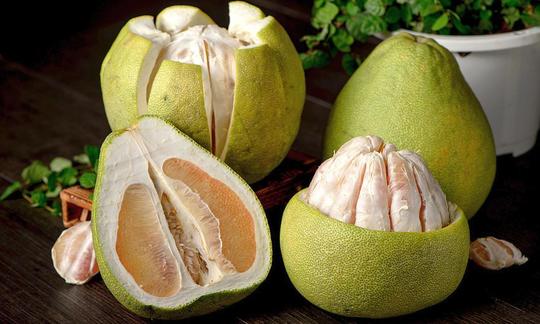

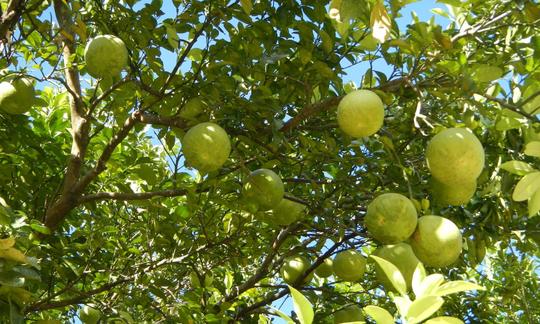

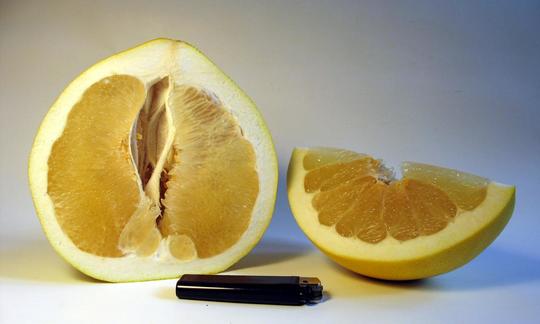

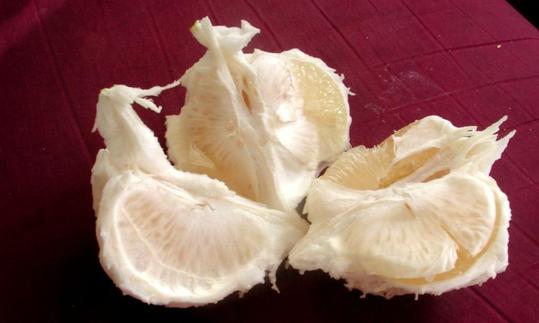

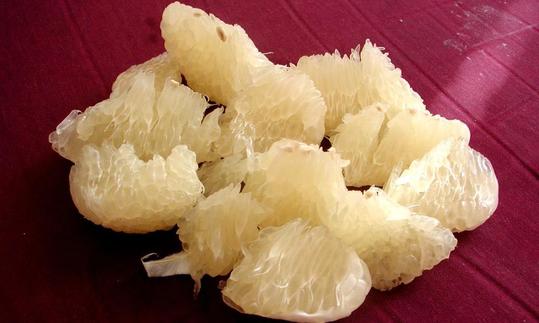

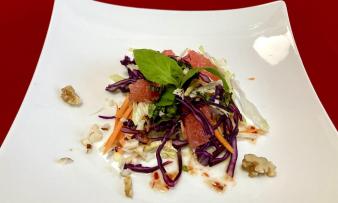
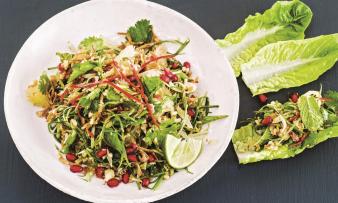



Comments